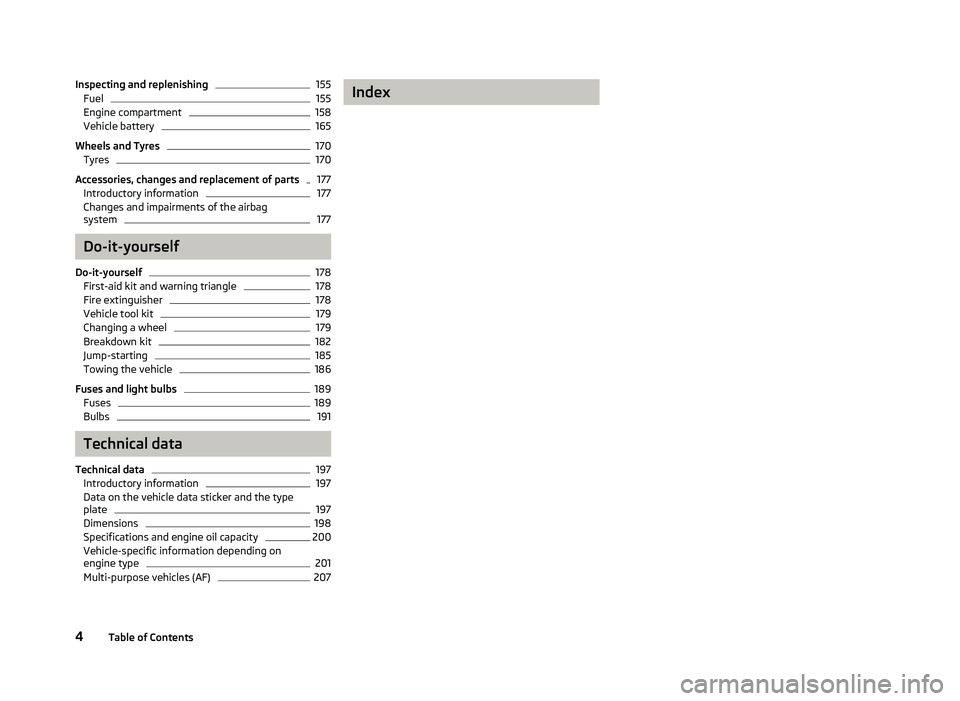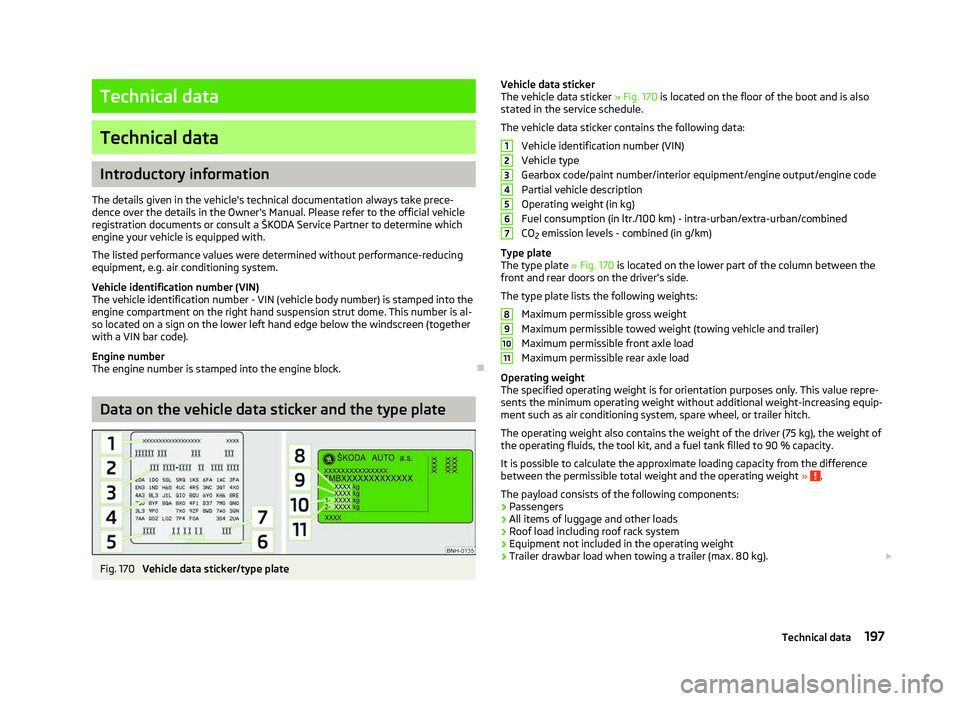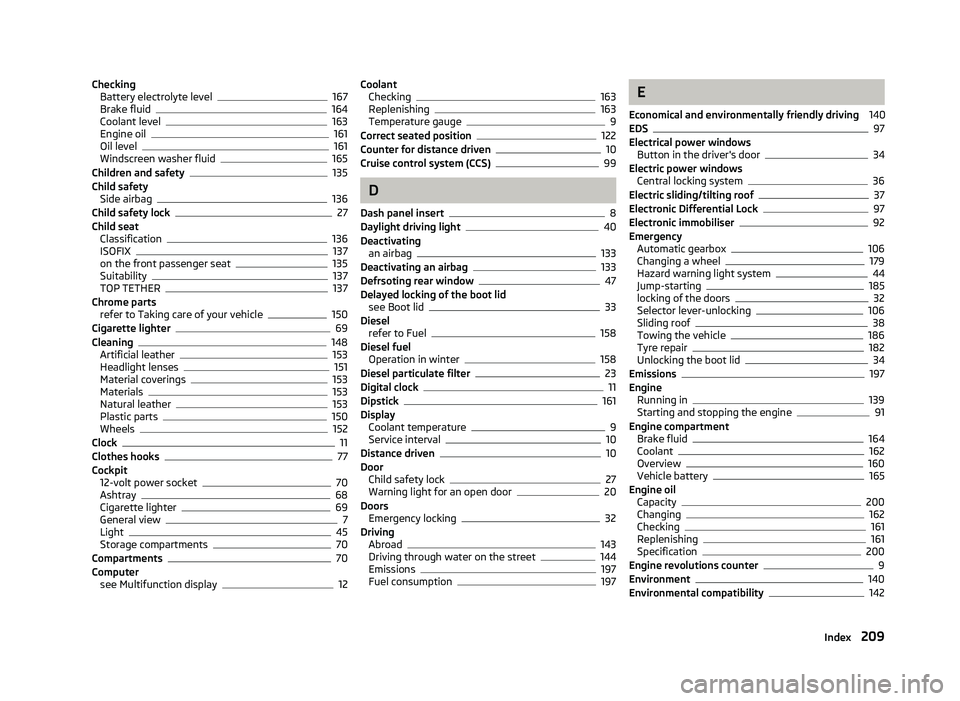towing capacity SKODA OCTAVIA 2006 Owner´s Manual
[x] Cancel search | Manufacturer: SKODA, Model Year: 2006, Model line: OCTAVIA, Model: SKODA OCTAVIA 2006Pages: 218, PDF Size: 5.48 MB
Page 6 of 218

Inspecting and replenishing 155
Fuel 155
Engine compartment 158
Vehicle battery 165
Wheels and Tyres 170
Tyres 170
Accessories, changes and replacement of parts 177
Introductory information 177
Changes and impairments of the airbag
system 177
Do-it-yourself
Do-it-yourself 178
First-aid kit and warning triangle 178
Fire extinguisher 178
Vehicle tool kit 179
Changing a wheel 179
Breakdown kit 182
Jump-starting 185
Towing the vehicle 186
Fuses and light bulbs 189
Fuses 189
Bulbs 191
Technical data
Technical data 197
Introductory information 197
Data on the vehicle data sticker and the type
plate 197
Dimensions 198
Specifications and engine oil capacity 200
Vehicle-specific information depending on
engine type 201
Multi-purpose vehicles (AF) 207 Index
4 Table of Contents
Page 163 of 218

Checking the engine oil level
Fig. 134
Dipstick
First read and observe the introductory information and safety warn-
ings on page 158.
The dipstick indicates the level of oil in the engine
» Fig. 134.
Checking the oil level
› Ensure that the vehicle is positioned on a level surface and the engine has
reached its operating temperature.
› Switch off the engine.
› Open the bonnet.
› Wait a few minutes until the engine oil flows back into the oil sump and remove
the dipstick.
› Wipe the dipstick with a clean cloth and insert it again to the stop.
› Then pull the dipstick out again and check the oil level.
Oil level within range A
›
No oil must be refilled.
Oil level within range B
›
Oil can
be refilled. It is possible that the oil level may then be within range A
after doing this.
Oil level within range C
›
Oil must be refilled. It is sufficient, once this is done, to keep the oil level within
range B
.
It is normal for the engine to consume oil. The oil consumption may be as much as
0.5 l/1 000 km depending on your style of driving and the conditions under which
you operate your vehicle. Consumption may be slightly higher than this during the
first 5 000 kilometres. ä
One should therefore check the oil level at regular intervals, preferably every time
after the fuel tank is filled or after driving for long stretches.
We recommend maintaining the oil level within the range A
, but not above
, if
the engine has been operating at high loads, for example, during a lengthy motor-
way trip during the summer months, towing a trailer or negotiating a high moun-
tain pass.
The warning light in the instrument cluster will indicate whether the oil level is
too low » page 21, Engine oil . In this case, check the oil level with the dip-
stick, as soon as possible. Add oil accordingly. CAUTION
■ The oil level must on no account extend beyond the range A
» Fig. 134. Risk of
damaging the exhaust system!
■ Do not continue your journey if for some reason it is not possible to top up
the engine oil under the prevailing conditions! Switch off the engine and obtain
professional assistance from a
ŠKODA specialist garage, otherwise it could cause
severe engine damage. Note
Engine oil specifications » page 200, Specifications and engine oil capacity .Ð Replenishing the engine oil
First read and observe the introductory information and safety warn-
ings on page 158.
›
Check the engine oil level
» page 161.
› Unscrew the cap of the engine oil filler opening.
› Replenish the oil in portions of 0.5 litres in accordance with the correct specifi-
cations » page 200, Specifications and engine oil capacity .
› Check the oil level
» page 161.
› Carefully screw on the oil filler opening cap and push the dipstick in fully. Ð
ä
161
Inspecting and replenishing
Page 199 of 218

Technical data
Technical data
Introductory information
The details given in the vehicle's technical documentation always take prece-
dence over the details in the Owner's Manual. Please refer to the official vehicle
registration documents or consult a
ŠKODA Service Partner to determine which
engine your vehicle is equipped with.
The listed performance values were determined without performance-reducing
equipment, e.g. air conditioning system.
Vehicle identification number (VIN)
The vehicle identification number - VIN (vehicle body number) is stamped into the
engine compartment on the right hand suspension strut dome. This number is al-
so located on a sign on the lower left hand edge below the windscreen (together
with a VIN bar code).
Engine number
The engine number is stamped into the engine block. ÐData on the vehicle data sticker and the type plate
Fig. 170
Vehicle data sticker/type plate Vehicle data sticker
The vehicle data sticker
» Fig. 170 is located on the floor of the boot and is also
stated in the service schedule.
The vehicle data sticker contains the following data:
Vehicle identification number (VIN)
Vehicle type
Gearbox code/paint number/interior equipment/engine output/engine code
Partial vehicle description
Operating weight (in kg)
Fuel consumption (in ltr./100
km) - intra-urban/extra-urban/combined
CO 2 emission levels - combined (in g/km)
Type plate
The type plate » Fig. 170 is located on the lower part of the column between the
front and rear doors on the driver's side.
The type plate lists the following weights:
Maximum permissible gross weight
Maximum permissible towed weight (towing vehicle and trailer)
Maximum permissible front axle load
Maximum permissible rear axle load
Operating weight
The specified operating weight is for orientation purposes only. This value repre-
sents the minimum operating weight without additional weight-increasing equip-
ment such as air conditioning system, spare wheel, or trailer hitch.
The operating weight also contains the weight of the driver (75 kg), the weight of
the operating fluids, the tool kit, and a fuel tank filled to 90 % capacity.
It is possible to calculate the approximate loading capacity from the difference
between the permissible total weight and the operating weight » .
The payload consists of the following components:
› Passengers
› All items of luggage and other loads
› Roof load including roof rack system
› Equipment not included in the operating weight
› Trailer drawbar load when towing a trailer (max. 80 kg).
£ 1
2
3
4
5
6
7
8
9
10
11
197
Technical data
Page 211 of 218

Checking
Battery electrolyte level 167
Brake fluid 164
Coolant level 163
Engine oil 161
Oil level 161
Windscreen washer fluid 165
Children and safety 135
Child safety Side airbag 136
Child safety lock 27
Child seat Classification 136
ISOFIX 137
on the front passenger seat 135
Suitability 137
TOP TETHER 137
Chrome parts refer to Taking care of your vehicle 150
Cigarette lighter 69
Cleaning 148
Artificial leather 153
Headlight lenses 151
Material coverings 153
Materials 153
Natural leather 153
Plastic parts 150
Wheels 152
Clock 11
Clothes hooks 77
Cockpit 12-volt power socket 70
Ashtray 68
Cigarette lighter 69
General view 7
Light 45
Storage compartments 70
Compartments 70
Computer see Multifunction display 12Coolant
Checking 163
Replenishing 163
Temperature gauge 9
Correct seated position 122
Counter for distance driven 10
Cruise control system (CCS) 99
D
Dash panel insert 8
Daylight driving light 40
Deactivating an airbag 133
Deactivating an airbag 133
Defrsoting rear window 47
Delayed locking of the boot lid see Boot lid 33
Diesel refer to Fuel 158
Diesel fuel Operation in winter 158
Diesel particulate filter 23
Digital clock 11
Dipstick 161
Display Coolant temperature 9
Service interval 10
Distance driven 10
Door Child safety lock 27
Warning light for an open door 20
Doors Emergency locking 32
Driving Abroad 143
Driving through water on the street 144
Emissions 197
Fuel consumption 197 E
Economical and environmentally friendly driving 140
EDS 97
Electrical power windows Button in the driver's door 34
Electric power windows Central locking system 36
Electric sliding/tilting roof 37
Electronic Differential Lock 97
Electronic immobiliser 92
Emergency Automatic gearbox 106
Changing a wheel 179
Hazard warning light system 44
Jump-starting 185
locking of the doors 32
Selector lever-unlocking 106
Sliding roof 38
Towing the vehicle 186
Tyre repair 182
Unlocking the boot lid 34
Emissions 197
Engine Running in 139
Starting and stopping the engine 91
Engine compartment Brake fluid 164
Coolant 162
Overview 160
Vehicle battery 165
Engine oil Capacity 200
Changing 162
Checking 161
Replenishing 161
Specification 200
Engine revolutions counter 9
Environment 140
Environmental compatibility 142
209
Index